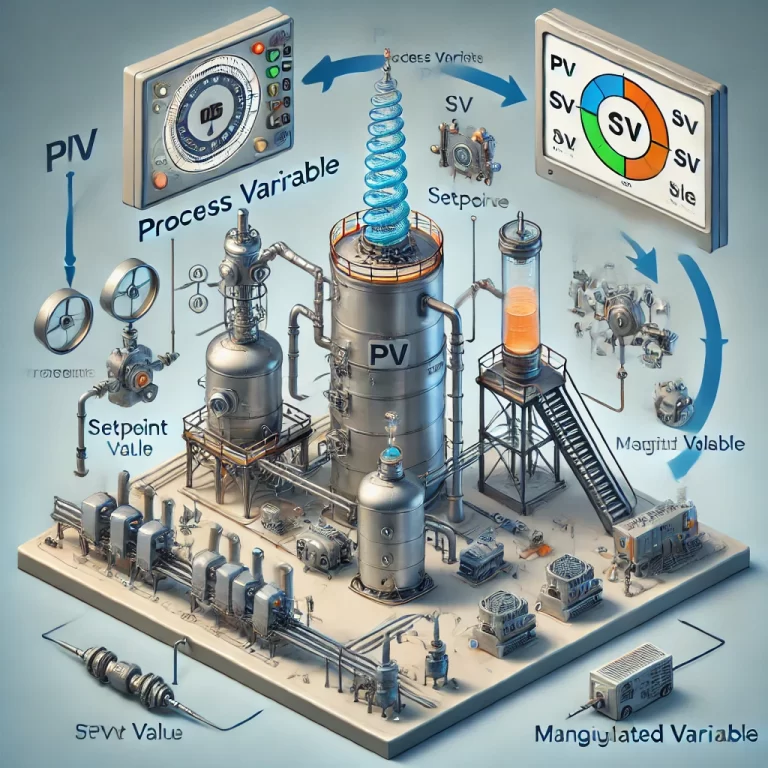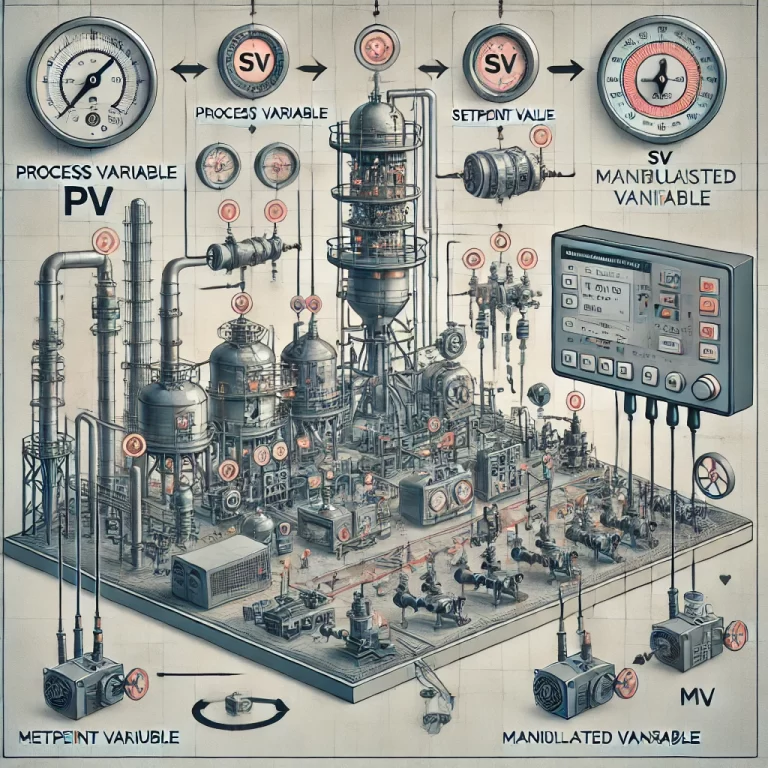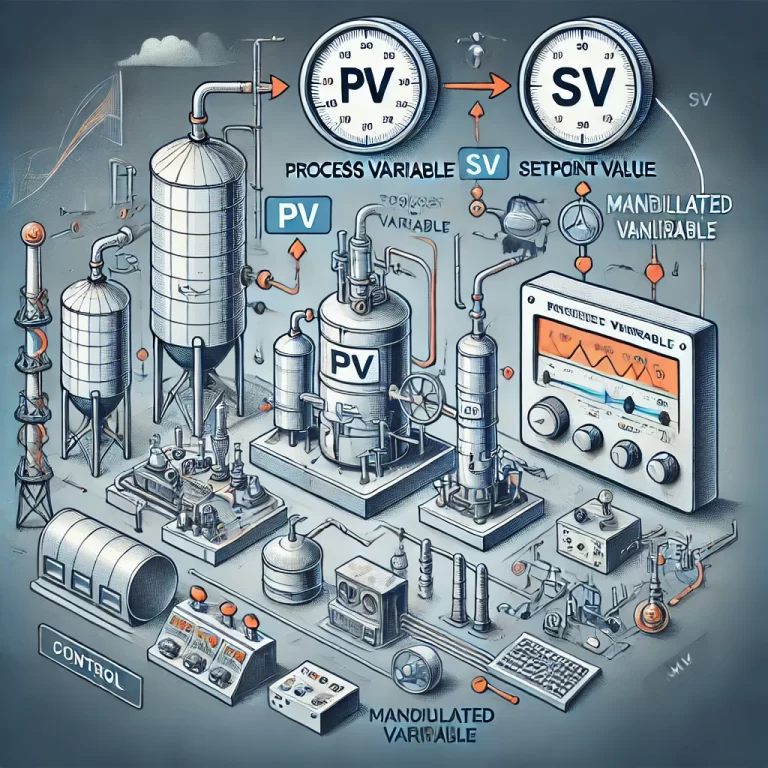Introduction
In the automation control systems of chemical plants, three key terms frequently appear: PV (Process Variable), SV (Setpoint Value), and MV (Manipulated Variable). These terms are commonly used in control loops, instrumentation control systems, and data monitoring. Understanding the relationship between these three variables is crucial for process engineers and operators to ensure stability, efficiency, and safety in industrial operations.
This article provides an in-depth exploration of PV, SV, and MV, their definitions, relationships, and practical applications in chemical plant automation.

1. PV (Process Variable) — The Measured Parameter
Definition: PV, or Process Variable, represents the actual state of a process in real-time. It is a key measurement obtained from sensors and transmitted to the control system for monitoring and regulation. Common process variables include temperature, pressure, flow rate, and liquid level, which vary depending on the specific production process in a chemical plant.
Example: In a chemical reactor, temperature and pressure are often critical process variables. Sensors continuously monitor these parameters and send real-time data to the control system. The system then evaluates these readings to determine if adjustments are necessary to maintain stable operation.
2. SV (Setpoint Value) — The Desired Target
Definition: SV, or Setpoint Value, is the predefined target that an operator or control system establishes for optimal process operation. It represents the ideal condition that the system aims to achieve.
Example: In a temperature control system, an operator might set an ideal reaction temperature (SV) to ensure a chemical reaction proceeds efficiently. The control system continuously compares the PV with the SV and makes necessary adjustments to maintain the process within the desired range.
Role in PID Control: In a Proportional-Integral-Derivative (PID) control system, the SV serves as the reference value. The system calculates the difference (error) between the PV and SV and adjusts the MV accordingly to bring the process variable closer to the desired setpoint.

3. MV (Manipulated Variable) — The Adjustment Parameter
Definition: MV, or Manipulated Variable, is the output that the control system modifies to influence the process variable (PV). It represents the actuator’s response to maintain the system at the desired setpoint.
Common Manipulated Variables:
Control valve opening percentage
Pump speed or flow rate
Heating element power
Cooling system flow rate
Example: If the temperature (PV) in a reactor exceeds the setpoint (SV), the control system may reduce the heating power or increase the coolant flow (MV) to lower the temperature.
4. Relationship Between PV, SV, and MV
The interaction between PV, SV, and MV is fundamental to process control, typically implemented through a feedback control loop. The relationship can be summarized as follows:
SV (Setpoint Value): The target state of the process.
PV (Process Variable): The actual state measured by sensors.
MV (Manipulated Variable): The corrective action taken by the control system to adjust PV and match SV.
Example in a Distillation Column: Consider a distillation column where the goal is to maintain a steady top temperature (SV). A temperature sensor measures the actual temperature (PV), and if there is a discrepancy between PV and SV, the control system adjusts the heat supply (MV) to bring the temperature back to the desired level.
Illustrative Diagram Suggestion
To enhance understanding, a simple diagram showing a PID control loop with PV, SV, and MV interactions would be beneficial.

5. Practical Applications in Chemical Plants
PV, SV, and MV interactions are widely applied in various automated control systems across chemical industries. Some key applications include:
a) Temperature Control
Example: In a chemical reactor, an operator sets an ideal reaction temperature (SV).
Process: A sensor measures the actual temperature (PV).
Adjustment: The control system regulates the heating element power (MV) to maintain the temperature within the desired range.
b) Pressure Control
Example: In a compressor system, maintaining a target pressure (SV) is crucial.
Process: A pressure sensor continuously monitors the actual system pressure (PV).
Adjustment: The control system adjusts the valve opening (MV) or compressor speed to maintain the set pressure.
c) Flow Rate Control
Example: In a pipeline system, maintaining a consistent flow rate (SV) is essential.
Process: A flow meter measures the actual flow rate (PV).
Adjustment: The system modifies the pump speed or valve position (MV) to regulate the flow.
d) Liquid Level Control
Example: In a storage tank, maintaining a specific liquid level (SV) is necessary.
Process: A level sensor measures the actual liquid height (PV).
Adjustment: The system controls the inflow and outflow rates (MV) using pumps and valves.

6. Additional Considerations for Optimized Process Control
To further enhance control system performance, process engineers should consider:
Advanced Control Strategies: Implementing cascade control, feedforward control, or model predictive control for improved accuracy.
Energy Efficiency: Optimizing MV adjustments to reduce energy consumption and minimize waste.
Safety Measures: Ensuring robust emergency shutdown mechanisms in case of extreme deviations from SV.
Remote Monitoring & AI Integration: Utilizing IoT and AI for predictive maintenance and real-time process optimization.
7. Conclusion
PV, SV, and MV form the foundation of automated process control in chemical plants. By continuously adjusting the manipulated variable (MV), the control system responds dynamically to environmental changes, ensuring that the process variable (PV) remains as close as possible to the desired setpoint (SV). A thorough understanding of these three variables enables engineers and operators to design, optimize, and maintain efficient and safe industrial processes.
By incorporating these principles into process control strategies, chemical plants can achieve higher productivity, improved product quality, and enhanced operational safety.
